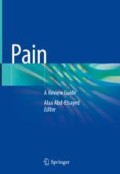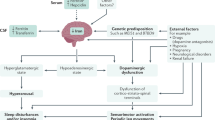Abstract
Restless Legs Syndrome, also known as Willis-Ekbom disease , is a sleeping disorder that produces an urge to move one’s legs, often accompanied by abnormal leg sensations. The International Restless Legs Syndrome Study Group developed a series of five standards in 2012. Restless Legs Syndrome is common and is associated with multiple risk factors. These risk factors include female gender, chronic renal disease, pregnancy, iron deficiency, anxiety, insomnia, and depression. Treatment for this disorder ranges from behavioral therapy such as mental stimulation, walking or any type of physical exercise to pharmacological therapy, including ropinirole, pramipexole and rotigotine patches, gabapentanoid agents, and opioids, depending on the severity of the disease.
Similar content being viewed by others
Keywords
Introduction
Restless Legs Syndrome (RLS), also referred to as Willis-Ekbom disease, is a widespread and common sleep disorder where patients experience an overwhelming urge to move their legs. The symptoms occur predominantly while sleeping or at rest, often with painful and irritating leg sensations. Patients respond by moving their legs in an effort to relieve the sensations. Among the general population, Ohayon et al.’s recent review of the literature found that 5–8.8% of adults suffer from one of the different types of severities of RLS [1]. Half of those patients had only mild or infrequent symptoms, while nearly twice as many women suffer from RLS than men. Other associated comorbidities include depression, anxiety, and insomnia [1].
Risk Factors
Numerous factors increase the risk for developing RLS. Iron deficiency, especially in elderly patients, remains a known risk factor, and iron supplementation can help reduce adverse symptoms in these cases [2]. Uremia due to end stage renal disease (ESRD) and chronic kidney disease (CKD) is another risk factor. RLS sometimes develops early in CKD, but more commonly occurs in ESRD [3]. Pregnancy also predisposes patients to RLS, developing in approximately 20% of pregnant females in first world countries [4]. In addition, RLS has been associated with several chronic conditions as congestive heart failure, diabetes mellitus, fibromyalgia and rheumatoid arthritis.
Diagnosis
In 2012, the International Restless Legs Syndrome Study Group (IRLSSG) introduced new standards for the diagnosis of RLS, including a new fifth diagnostic criteria [5]. All five of the following conditions must be met to formally diagnose RLS. Firstly, patients must experience an inclination or urge to move their legs, usually associated with unpleasant feelings in the affected extremities. The urge to move is most commonly afflicts the lower limbs but in rare cases extends to the upper limbs. The unpleasant sensation is normally described as cramping, crawling, or a shock-like feeling. Secondly, the inclination to move must occur during periods of inactivity, such as lying down in bed. Thirdly, the impulse to move and any adverse feelings should be at least partially relieved by moving the limbs with activity such as walking or jogging. The fourth diagnostic criteria mandates that the condition and any accompanying ill-feelings are worse at night compared to the day. In severe cases of RLS, it may be difficult to decipher if the urge is more difficult at night. Finally, the first four criteria must not be the byproduct of another primary medical or psychiatric condition. The fifth requirement is new and implemented as a means of ruling similar diagnoses [5]. Again, all five criteria must be met for a clinician to diagnose RLS. When considering a diagnosis of RLS, clinicians should include in their work up a basic metabolic panel to assess kidney function, a complete blood count with peripheral smear, and an iron profile to check for iron deficiency.
Treatment
Treatment of RLS ranges over a broad spectrum of therapies depending on disease severity. Patients with mild disease can be treated with multiple types of behavioral therapy. Walking or any type of physical exercise can alleviate symptoms of mild RLS. Mentally stimulating activity, such as chess or crossword puzzles, has been shown to decrease the urge of RLS when at rest [2]. Many clinicians advise patients to cut down on caffeine and to quit smoking despite little evidence to support this recommendation. Alcohol consumption causes sleep cycle disturbances and may worsen RLS symptoms; consequently, alcohol cessation may decrease RLS symptoms [2]. Antihistamines, antinausea, and antiemetic drugs can exacerbate the urge symptoms of RLS, and patients should be advised to avoid these medications. Antidepressants such as tricyclic antidepressants, SSRIs, and SNRIs have been shown to exacerbate RLS symptoms, but these medications should not be discontinued depending on the patient’s mental state and depressive actions. Patients with serum ferritin levels less than 45 mcg should be treated with oral iron therapy, which is proven to decrease impulse and overall RLS symptoms in iron deficient patients [2].
Pharmacologic therapy remains the mainstay treatment of patients with moderate to severe RLS. Dopamine agonists such as ropinirole and pramipexole are first line therapies for RLS, and in fact were the first two FDA-approved medications indicated for moderate to severe RLS. Side effects of ropinirole and pramipexole are dose-related and include dizziness, hypotension, nausea, fatigue, and insomnia. These medications can aggravate impulse control disorders and should not be prescribed to patients with known impulse control disorders. Ropinirole is metabolized by the liver and is contraindicated in patients with liver failure, whereas pramipexole is metabolized by the kidney [2]. Rotigotine patches, a new dopaminergic medication, have demonstrated efficacy in treating RLS as a once daily 24 h patch. Adverse side effects of dopamine agonist therapy for RLS includes augmentation of symptoms. Augmentation generally occurs after months to years of dopaminergic therapy, with patients experiencing increases in symptom severity, frequency, and medication requirement [2]. The first non-dopaminergic medication approved to treat patients suffering from RLS was the anticonvulsant drug gabapentin. Some physicians consider gabapentin, as well as gabapentin enacarbil and pregabalin, a first line medication as it treats the neuropathy associated with RLS as well as the insomnia [2]. Patients who fail to respond to either dopamine agonists or anticonvulsants can use opioid medications as a last line therapy. Opioids can be used in concert with anticonvulsants and dopaminergic drugs in a multimodal strategy, or alone as a monotherapy. Pain specialists normally reserve treatment with methadone for patients with severe RLS that have failed all other therapies, as this opioid has demonstrated encouraging results for treatment refractory RLS [2].
Differential Diagnosis
-
Periodic limb movement of sleep.
-
Rythmic movement disorder. Characterized by specific type of movement when waking up and usually in children.
-
Nocturnal leg cramps.
-
Bruxism. Characterized by teeth grinding and jaw contractions.
High Yield Points
-
Restless Legs Syndrome (RLS) is sleep disorder that produces an urge or impulse to move one’s legs, often accompanied by abnormal leg sensations.
-
Iron deficiency is a risk factor for developing restless legs syndrome.
-
Patients with mild RLS can be treated with behavioral therapy.
-
Ropinirole and pramipexole are first line therapies for RLS.
-
Side effects of ropinirole and pramipexole are dose-related and include dizziness, hypotension, nausea, fatigue, insomnia, and aggravation of impulse control disorders.
Questions
-
1.
Which is the following is NOT an adverse reaction of ropinirole?
-
A.
Fatigue
-
B.
Hypertension
-
C.
Nausea
-
D.
Dizziness
-
Answer: B
-
A.
-
2.
Which one of the following lab tests should be ordered when diagnosing Restless Legs Syndrome?
-
A.
Hepatitis Panel
-
B.
CSF 14–3-3 protein
-
C.
Iron Profile
-
D.
Alpha-fetoprotein
-
Answer: C
-
A.
-
3.
With medication is used to treat patients with severe RLS who have failed all other options?
-
A.
Methadone
-
B.
Gabapentin
-
C.
Oxycodone
-
D.
Rotigotine patch
-
Answer: A
-
A.
References
Ohayon MM, O'Hara R, Vitiello MV. Epidemiology of restless legs syndrome: a synthesis of the literature. Sleep Med Rev. 2012;16(4):283–95.
Buchfuhrer MJ. Strategies for the treatment of restless legs syndrome. Neurotherapeutics. 2012;9(4):776–90.
Lee J, Nicholl DD, Ahmed SB, Loewen AH, Hemmelgarn BR, Beecroft JM, Turin TC, Hanly PJ. The prevalence of restless legs syndrome across the full spectrum of kidney disease. J Clin Sleep Med. 2013;9(5):455–9.
Picchietti DL, Hensley JG, Bainbridge JL, Lee KA, Manconi M, McGregor JA, Silver RM, Trenkwalder C, Walters AS, International Restless Legs Syndrome Study Group (IRLSSG). Consensus clinical practice guidelines for the diagnosis and treatment of restless legs syndrome/Willis-Ekbom disease during pregnancy and lactation. Sleep Med Rev. 2015;22:64–77.
Allen RP, Picchietti DL, Garcia-Borreguero D, Ondo WG, Walters AS, Winkelman JW, Zucconi M, Ferri R, Trenkwalder C, Lee HB, International Restless Legs Syndrome Study Group. Restless legs syndrome/Willis-Ekbom disease diagnostic criteria: updated international restless legs syndrome study group (IRLSSG) consensus criteria – history, rationale, description, and significance. Sleep Med. 2014;15(8):860–73.
Author information
Authors and Affiliations
Corresponding author
Editor information
Editors and Affiliations
Rights and permissions
Copyright information
© 2019 Springer Nature Switzerland AG
About this chapter
Cite this chapter
Ehrhardt, K.P., Jones, M.R., Kaye, A.D. (2019). Restless Legs Syndrome. In: Abd-Elsayed, A. (eds) Pain. Springer, Cham. https://doi.org/10.1007/978-3-319-99124-5_272
Download citation
DOI: https://doi.org/10.1007/978-3-319-99124-5_272
Published:
Publisher Name: Springer, Cham
Print ISBN: 978-3-319-99123-8
Online ISBN: 978-3-319-99124-5
eBook Packages: MedicineMedicine (R0)




